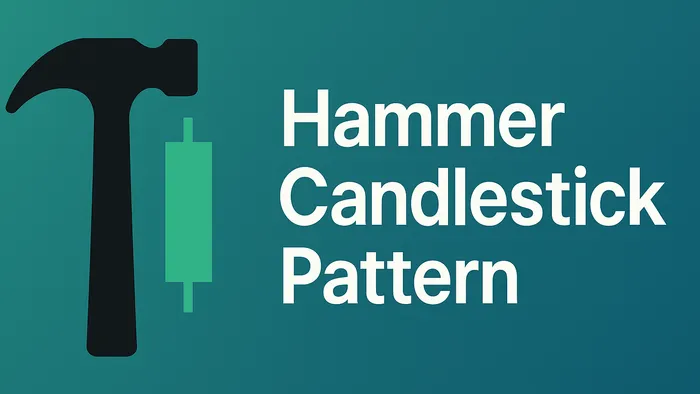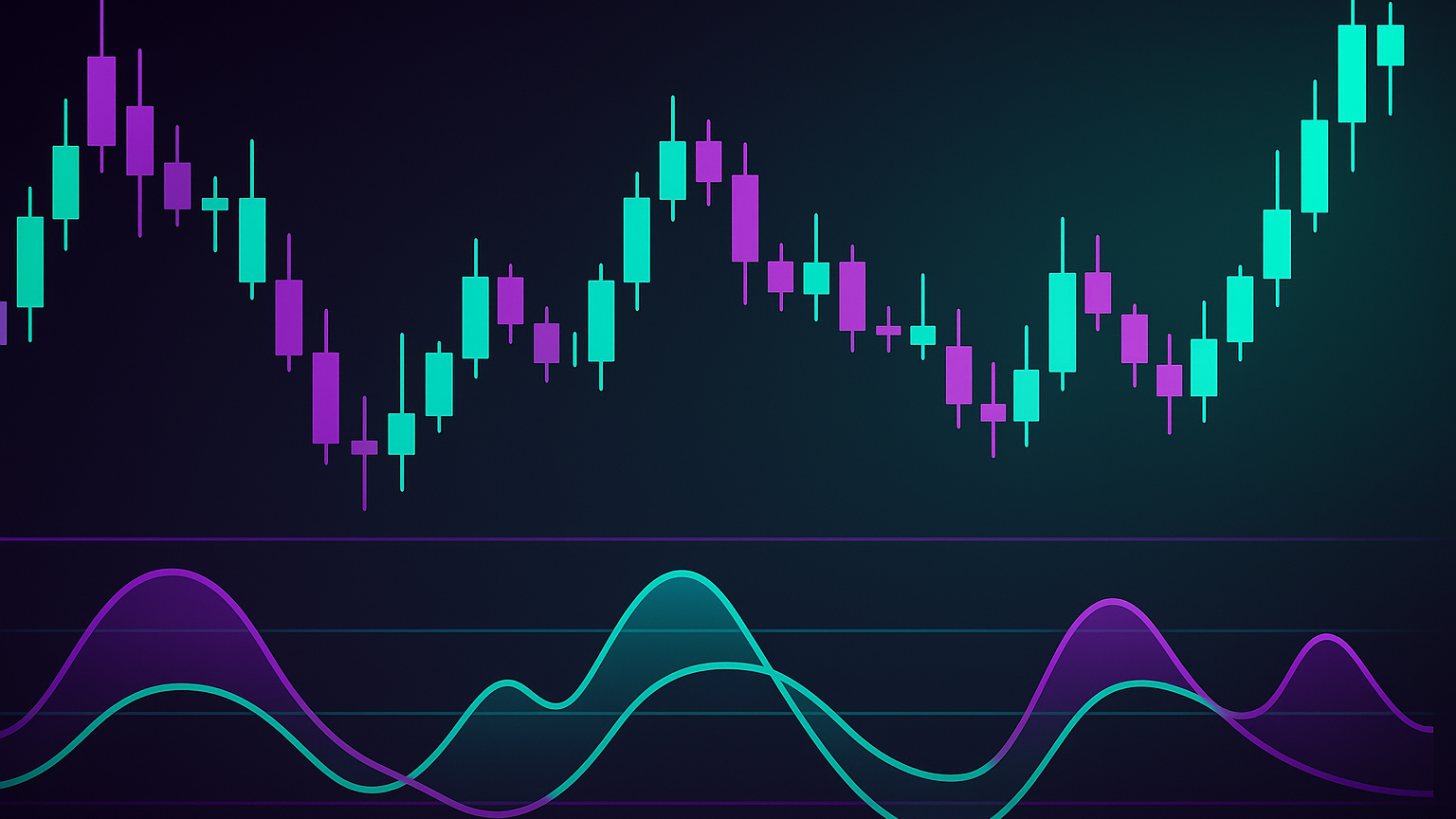Learn how to identify and trade the hammer candlestick pattern, a powerful signal for potential bullish reversals in downtrends.
The hammer candlestick pattern is a key signal for traders to identify potential bullish reversals during a downtrend. Its unique "T" shape, with a small body and a long lower shadow, signals strong buyer recovery and a possible trend shift. Here’s what you need to know:
- What it is: A hammer forms after a downtrend, with a small real body near the top, a lower shadow at least twice the body’s length, and little to no upper shadow.
- Why it matters: It has a 63% success rate in predicting reversals, especially when confirmed by high trading volume or support levels.
- How to use it: Validate with bullish momentum, technical indicators (e.g., RSI), and key support zones before entering trades.
What is a Hammer Candlestick Pattern
Spotting Hammer Patterns
To identify a hammer pattern, you need to focus on its visual traits and the market conditions surrounding it. Below, we break down the pattern's structure and the factors that confirm its reliability.
Main Pattern Parts
A hammer pattern has three key components: a small body positioned near the top, a lower shadow that's at least twice the length of the body, and little to no upper shadow.
| Component | Characteristic | What It Indicates |
|---|---|---|
| Real Body | Small, at the top | Closing price near the session high |
| Lower Shadow | At least 2x the body length | Strong buyer recovery during the session |
| Upper Shadow | Minimal or none | Buyers dominated the session |
Market Setup Requirements
The hammer pattern works best when it forms after a clear downtrend. This is why its appearance is relatively uncommon. A study from 1997 found that hammer patterns have a 50–65% success rate in signaling bullish reversals when they follow a downtrend.
Here are the key market conditions that boost the hammer's reliability:
- It must appear after a well-defined price decline.
- Ideally, it forms near trendlines or Fibonacci retracement levels.
- Higher trading volume compared to recent periods strengthens the signal.
Pattern Confirmation Steps
Once you've identified the pattern and its market context, take these steps to confirm the signal:
"The hammer candlestick also strengthens the importance of support levels. When it forms near these levels, it confirms that buyers are stepping in, stopping further price drops, and possibly pushing prices higher."
-
Price Action Confirmation
Look for bullish momentum in the next 1–2 candles. This could be a close above the hammer's high, a bullish engulfing pattern, or an upside gap. -
Technical Validation
Use technical indicators to verify the signal, such as:- RSI moving upward from oversold levels
- A break of the prior downtrend line
- Increased trading volume compared to recent sessions
-
Support Level Analysis
Check if the hammer's low aligns with:- Historical support zones
- Fibonacci retracement levels
- Trendline support
These steps help confirm whether the hammer pattern is signaling a potential bullish reversal.
Trading with Hammer Patterns
Trade Entry and Exit Rules
Hammer patterns work best when confirmed by additional signals. The trick is to wait for that extra validation before jumping in.
Here's a simple guide to structuring your trades:
| Trade Component | Rule | Why It Matters |
|---|---|---|
| Entry Timing | Enter after a confirmation candle forms | Helps filter out false signals |
| Entry Price | Buy at the next candle's opening price | Ensures a clear and actionable entry point |
| Initial Position | Size your position based on the stop-loss distance | Keeps your risk under control |
| Exit Conditions | Exit when the profit target is reached or stop-loss is hit | Encourages disciplined trading |
Setting Stop-Loss and Profit Targets
Managing risk is non-negotiable in trading. Let’s break it down with an example: If you enter a trade at $100 and aim for a 1:2 risk-reward ratio, you’d set your stop-loss at $95 and your profit target at $110. This setup limits your risk to $5 while aiming for a $10 gain.
- Place your stop-loss just below the hammer's low to protect against downside moves.
- In volatile markets, consider wider stops to avoid being stopped out too soon.
- Use nearby resistance levels as logical profit targets.
- Adjust your targets depending on the current market's volatility.
Adding Other Technical Tools
Hammer patterns become even more effective when paired with other technical indicators. Use the T.A.E. Formula – Trend, Area of Value, Entry Trigger – to refine your strategy.
1. Trend Analysis
- If the price is above the 200-day moving average (MA), maintain a bullish bias.
- If the price is below the MA, be cautious with long positions.
2. Support/Resistance Levels
- Historical support zones
- Key Fibonacci retracement levels
- Trendline intersections
3. Momentum Confirmation
- RSI should indicate oversold conditions.
- Money Flow should show buying pressure.
- Use tools like the Hyper Wave oscillator to confirm trend direction.
Pattern Examples in Markets
Successful Pattern Trades
Example: Boeing (BA) Stock in Early 2022
Boeing's stock demonstrated a textbook hammer pattern during its price drop from $233 to $180 between November 2021 and January 2022. This pattern hinted at a potential reversal.
| Date | Price Action | Volume | Signal |
|---|---|---|---|
| Jan 27, 2022 | Bearish engulfing candle | High | Downtrend continuation |
| Jan 28, 2022 | Hammer forms at $169.86, closes at $186.61 | Above average | Potential reversal |
| Jan 31, 2022 | Gap up to $206.61 | Very high | Pattern confirmation |
- The hammer appeared at the end of a downtrend.
- Buyers stepped in strongly at the lows.
- High trading volume supported the hammer and its confirmation.
- The price broke above the hammer's high, signaling a reversal.
Unsuccessful Pattern Trades
- Volume confirmation is weak or absent.
- The market lacks a clear downtrend.
- Additional validation signals are missing.
How to improve outcomes:
- Look for strong volume to confirm the pattern.
- Focus on hammers forming in clear downtrends near major support levels.
- Combine hammer signals with other confirmation tools.
- Always set stop-loss orders to manage risk.
Pattern Trading Mistakes
Single Pattern Risk
Research shows hammer patterns appear in only 1.1% of cases, with a 58% success rate. Relying solely on the pattern without additional context can be risky. Here's how to approach it more effectively:
- Look for a clear downtrend before trading.
- Identify strong support levels.
- Use technical indicators for confirmation.
- Wait for a bullish signal to validate the setup.
"Like all trading patterns, the Hammer Candlestick pattern should be used in conjunction with other technical analysis tools for best results."
Poor Risk Control
| Risk Management Component | Common Mistake | Recommended Approach |
|---|---|---|
| Stop Loss Placement | No stop loss or too loose | Place stop loss just below the hammer's low |
| Position Sizing | Taking oversized positions | Keep position sizes manageable to limit risk |
| Profit Targets | No clear exit strategy | Set profit targets at key resistance levels |
| Risk-Reward Ratio | Poor ratios (e.g., 1:1) | Aim for at least a 1:2 risk-reward ratio |
Screening Bad Signals
Hammer patterns are most reliable as bullish reversal signals, with a win rate of 63% when identified correctly. To filter out weak signals:
- Check volume levels to validate the pattern.
- Ensure the shadow length aligns with earlier guidelines.
- Confirm proximity to support levels.
- Use higher timeframes for more dependable signals.
"The turning point came when I realized that a signal on its own is not enough. I needed to consider the context in which the signal was appearing." – Andrew Rul Trading
Conclusion
Trading with hammer patterns effectively combines technical analysis, risk management, and understanding the market's overall context. According to CandleScanner, hammer patterns occur in only about 1% of cases, while Thomas Bulkowski estimates they have a 60% likelihood of signaling a bullish reversal.
Key Strategies for Success
To improve your hammer pattern trading, focus on these practical strategies:
| Factor | Key Approach |
|---|---|
| Pattern Validation | Ensure a clear downtrend and check for increased volume. |
| Risk Management | Use protective stop-loss orders and favorable risk-reward ratios. |
| Technical Alignment | Combine with support levels and other technical indicators. |
| Market Context | Identify strong support zones for better accuracy. |
For example, in EURUSD trading, setting stop-loss orders 50 pips below the hammer's low (e.g., at 1.0950 for a 1.1000 low) provides a balance between protection and market fluctuations.
Pair hammer patterns with tools like volume analysis and indicators such as RSI or MACD. This layered approach filters weaker setups and highlights stronger opportunities, helping traders adapt to various market conditions.
References
- Fibonacci Retracement Levels – LuxAlgo Price Action Concepts Toolkit
- Bullish Reversal Signals – LuxAlgo Oscillator Matrix Toolkit
- Stop-Loss & Profit Targets – LuxAlgo S&O Backtester
- Thomas Bulkowski’s Pattern Site
- CandleScanner
- Hammer Candlestick Pattern – Investopedia
- Hammer Candlestick – Wikipedia








